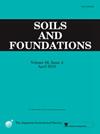靠近活动断裂带的高面板堆石坝地震边坡破坏可靠度评估
IF 3.3
2区 工程技术
Q2 ENGINEERING, GEOLOGICAL
引用次数: 0
摘要
采用基于可靠度的分析方法,对受附近活动断层影响的混凝土面板坝上下游边坡地震破坏风险进行了评估。为此,根据条件概率定理,对坝址可能出现的峰值地加速度(pga)进行了概率计算,并确定了它们对坝坡滑动风险的贡献。在世界范围内,cfrd的上、下游坡度通常分别设计为1.3 ~ 1.5 h:1V和1.3 ~ 1.6 h:1V。这种坡度设计被认为对几乎所有情况都是足够的。研究结果对世界范围内混凝土面板堆石坝的结构设计具有一定的参考价值。由于cfrd的坡度设计相似,通常采用传统的(1.3-1.5H;上游坡1V,下游坡1.4-1.6H:1V)。然而,本研究证明,对于附近活动断层产生的峰值地加速度(pga),只有传统的上游边坡设计(1.3-1.5H:1V)才能保证安全,而与预期相反,当峰值地加速度达到较高水平时,cfrd下游边坡不能足够安全并保持边坡滑动安全。当超过临界PGA水平时,下游边坡具有高概率失稳风险,这是本研究所强调的。因此,本研究为大坝设计工程师提供了一种新的设计策略和极其重要的信息,即设计一个相当平坦的下游斜坡,如1垂直到1.8-2.0水平,或者在地震高发区或靠近活动断层的地区建造cfrd,而不是设计一个支持常规设计的下游堆石护堤。建议这种设计既经济又足够安全。本文章由计算机程序翻译,如有差异,请以英文原文为准。
Reliability based seismic slope failure assessment of a high concrete face rockfill dam close to an active fault zone
This study assesses the earthquake-induced failure risks of the upstream and downstream slopes of a concrete face dam (CFRD), which is under the influence of a nearby active fault, using the reliability-based analysis method. For this purpose, peak ground accelerations (PGAs) that may occur at the dam site were calculated probabilistically and their contribution to the sliding risks of dam slopes was determined in accordance with the conditional probability theorem. Upstream and downstream slopes of CFRDs are usually conventionally designed as 1.3–1.5H:1V and 1.3–1.6H:1V, respectively throughout the world. Such slope design is considered sufficient for almost every case. The findings of this study are fully applicable and very important for the structural design of all concrete-faced rockfill dams (CFRDs) worldwide. Since, the slope design of CFRDs is similar and usually traditionally (1.3–1.5H; 1V for upstream slope and 1.4–1.6H:1V for downstream slope). However, this study proves that only conventional upstream slope design (1.3–1.5H:1V) can be safe for even very high peak ground accelerations (PGAs) occurring due to a nearby active fault, but contrary to expectations, downstream slope of CFRDs cannot be sufficiently safe and maintain its slope sliding safety when PGAs reach high levels. When the critical PGA level is exceeded, the downstream slope carries the risk of losing its stability with high probability, as emphasized in this study. Therefore, this study provides a new design strategy and extremely important information for dam design engineers which is to design a rather flatter downstream slope such as 1 vertical to 1.8–2.0 horizontal or, instead, to design a downstream rockfill berm supporting conventional design if CFRDs are to be built in high seismic hazard potential areas or close to active faults. Suggested such type of designs will be economical and sufficiently safe.
求助全文
通过发布文献求助,成功后即可免费获取论文全文。
去求助
来源期刊

Soils and Foundations
工程技术-地球科学综合
CiteScore
6.40
自引率
8.10%
发文量
99
审稿时长
5 months
期刊介绍:
Soils and Foundations is one of the leading journals in the field of soil mechanics and geotechnical engineering. It is the official journal of the Japanese Geotechnical Society (JGS)., The journal publishes a variety of original research paper, technical reports, technical notes, as well as the state-of-the-art reports upon invitation by the Editor, in the fields of soil and rock mechanics, geotechnical engineering, and environmental geotechnics. Since the publication of Volume 1, No.1 issue in June 1960, Soils and Foundations will celebrate the 60th anniversary in the year of 2020.
Soils and Foundations welcomes theoretical as well as practical work associated with the aforementioned field(s). Case studies that describe the original and interdisciplinary work applicable to geotechnical engineering are particularly encouraged. Discussions to each of the published articles are also welcomed in order to provide an avenue in which opinions of peers may be fed back or exchanged. In providing latest expertise on a specific topic, one issue out of six per year on average was allocated to include selected papers from the International Symposia which were held in Japan as well as overseas.
 求助内容:
求助内容: 应助结果提醒方式:
应助结果提醒方式:


